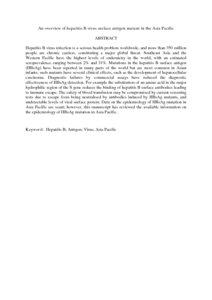Citation
Shuaibu, Hudu Abdullahi and A. Malik, Yasmin and Mohd Taib, Niazlin and Mohammed Harmal, Nabil Saad and Sekawi, Zamberi
(2014)
An overview of hepatitis B virus surface antigen mutant in the Asia Pacific.
Current Issues in Molecular Biology, 16.
pp. 69-77.
ISSN 1467-3037; ESSN: 1467-3045
Abstract
Hepatitis B virus infection is a serious health problem worldwide, and more than 350 million people are chronic carriers, constituting a major global threat. Southeast Asia and the Western Pacific have the highest levels of endemicity in the world, with an estimated seroprevalence ranging between 2% and 31%. Mutations in the hepatitis B surface antigen (HBsAg) have been reported in many parts of the world but are most common in Asian infants; such mutants have several clinical effects, such as the development of hepatocellular carcinoma. Diagnostic failures by commercial assays have reduced the diagnostic effectiveness of HBsAg detection. For example the substitution of an amino acid in the major hydrophilic region of the S gene reduces the binding of hepatitis B surface antibodies leading to immune escape. The safety of blood transfusion may be compromised by current screening tests due to escape from being neutralised by antibodies induced by HBsAg mutants, and undetectable levels of viral surface protein. Data on the epidemiology of HBsAg mutation in Asia Pacific are scant; however, this manuscript has reviewed the available information on the epidemiology of HBsAg mutation in Asia Pacific.
Download File
![[img]](http://psasir.upm.edu.my/29763/1.hassmallThumbnailVersion/An%20overview%20of%20hepatitis%20B%20virus%20surface%20antigen%20mutant%20in%20the%20Asia%20Pacific.pdf)  Preview |
|
PDF (Abstract)
An overview of hepatitis B virus surface antigen mutant in the Asia Pacific.pdf
Download (85kB)
| Preview
|
|
Additional Metadata
Actions (login required)
 |
View Item |

